check engine CHEVROLET CAMARO 1994 4.G Service Manual
[x] Cancel search | Manufacturer: CHEVROLET, Model Year: 1994, Model line: CAMARO, Model: CHEVROLET CAMARO 1994 4.GPages: 292, PDF Size: 15.35 MB
Page 205 of 292
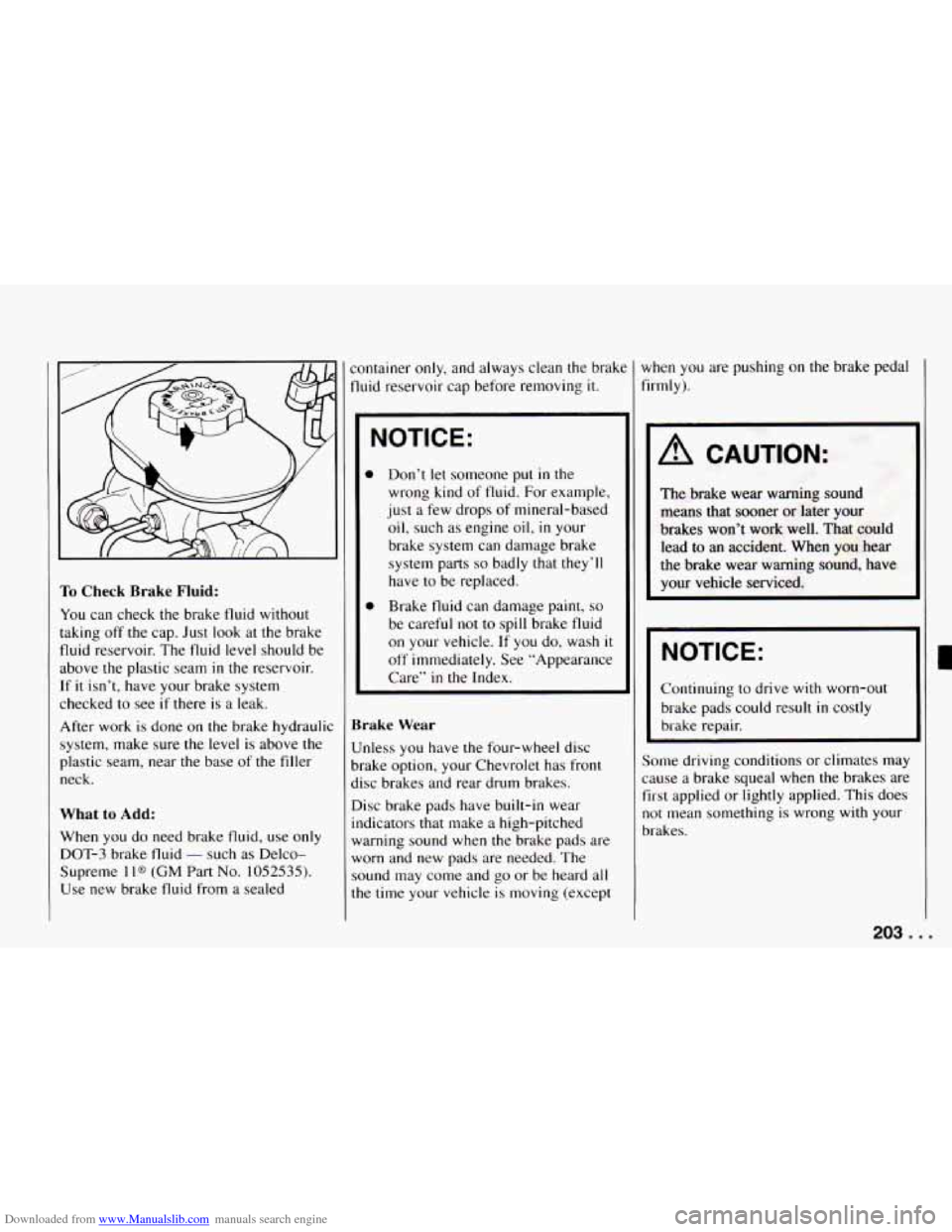
Downloaded from www.Manualslib.com manuals search engine To Check Brake Fluid:
You can check the brake fluid without
taking off the cap. Just look at the brake
fluid reservoir. The fluid level should be
above the plastic seam
in the reservoir.
If it isn’t, have your brake system
checked to see
if there is a leak.
After work is done on the brake hydraulic
system, make sure the level
is above the
plastic seam, near the base of the filler
neck.
What to Add:
When you do need brake fluid, use only
DOT-3 brake fluid
- such as Delco-
Supreme 1 l@ (GM Part No. 1052535).
Use new brake fluid from a sealed container
only, and always clean the brakt
fluid reservoir cap before removing it.
NOTICE:
0 Don’t let someone put in the
wrong kind
of fluid. For example,
just a few drops
of mineral-based
oil, such as engine oil, in your
brake system can damage brake
system parts
so badly that they’ll
have to be replaced.
0 Brake fluid can damage paint, so
be careful not to spill brake fluid
on your vehicle.
If you do, wash it
off immediately. See ”Appearance
Care”
in the Index.
Brake Wear
Unless you have the four-wheel disc
brake option, your Chevrolet has front
disc brakes and rear drum brakes.
Disc brake pads have built-in wear
indicators that make
a high-pitched
warning sound when the brake pads are
worn and new pads are needed. The
sound may come and go or be heard all
the time your vehicle is moving (except when
you are
pushing on the brake pedal
firmly).
A CAUTION:
The brake wear warning sound
means that sooner or later your
brakes won’t work well. That could
lead to an accident. When you hear
the brake wear warning sound, have
your vehicle serviced.
NOTICE:
Continuing to drive with worn-out
brake pads could result in costly
brake repair.
Some driving conditions or climates may
cause
a brake squeal when the brakes are
first applied or lightly applied. This does
not mean something is wrong
with your
brakes.
203. I
Page 207 of 292
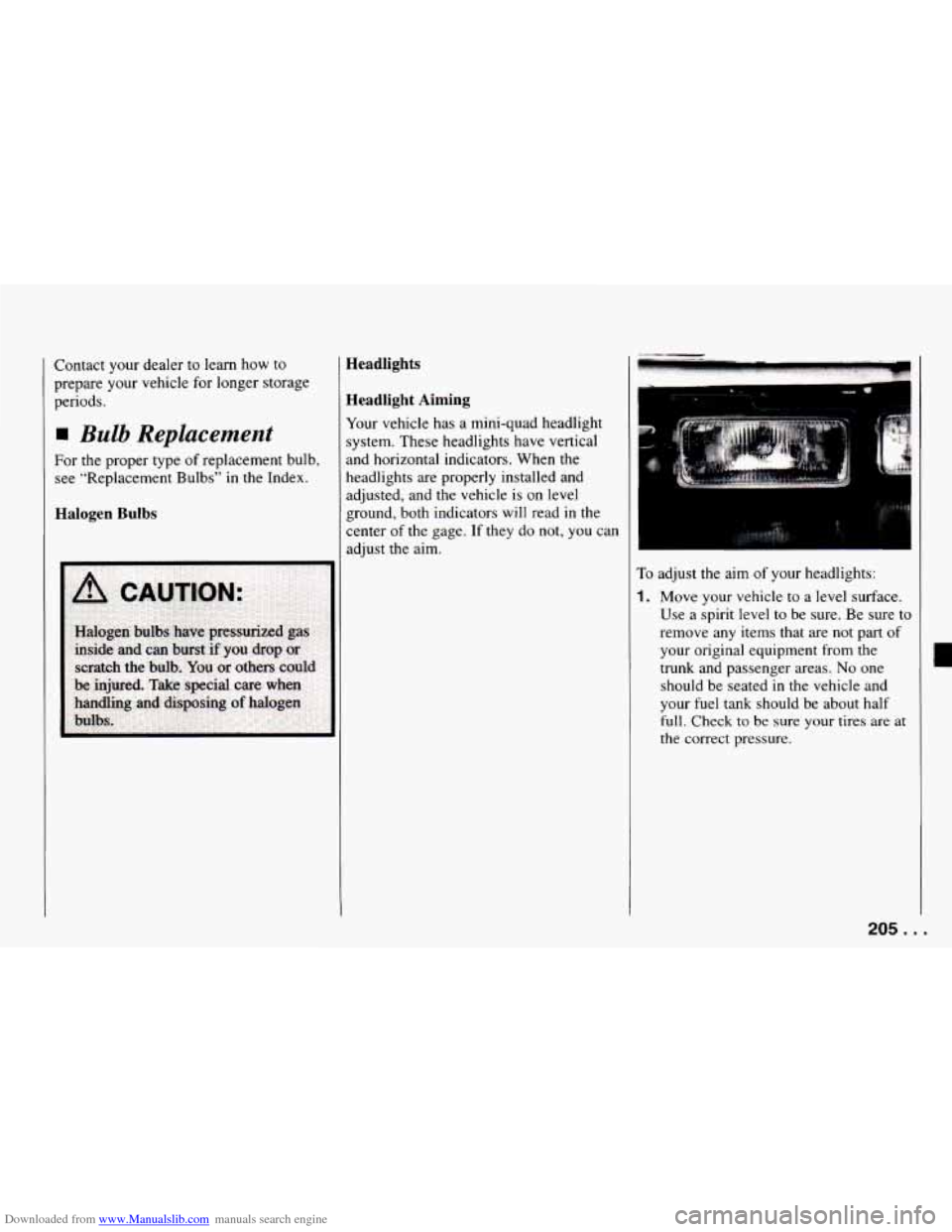
Downloaded from www.Manualslib.com manuals search engine Contacr your dealer to learn how to
prepare your vehicle for longer storage
periods.
Bulb Replacement
For the proper type of replacement bulb,
see “Replacement Bulbs”
in the Index.
Halogen Bulbs Headlights
Headlight Aiming
Your
vehicle has a mini-quad headlight
system. These headlights have vertical
and horizontal indicators. When the
headlights are properly installed and
adjusted, and the vehicle is on level
ground, both indicators will read in the
:enter of the gage.
If they do not, you can
adjust the aim.
To adjust the aim of your headlights:
1. Move your vehicle to a level surface.
Use a spirit level to be sure. Be sure to
remove any items that are not part of
your original equipment from the
trunk and passenger areas.
No one
should be seated
in the vehicle and
your fuel tank should be about half
full. Check to be sure your tires are at
the correct pressure.
205. .
Page 208 of 292

Downloaded from www.Manualslib.com manuals search engine Service and Appearance Care
There are four headlights. Each one has
its own vertical and horizontal aim
position indicators. Each indicator has
its own aiming screw.
A. Vertical Indicator
B. Horizontal Indicator
C. Vertical Aiming Screw
D. Horizontal Aiming Screw
II
!.
I.
I.
Start with the horizontal (left and
right) headlight aim. Don't try to
adjust the vertical (up and down) aim
first.
Check the horizontal aim for each
headlight and adjust
it as necessary.
Turn the horizontal aiming screw
until
the pointer is lined up with the 0
(zero).
5. Now adjust the vertical aim. Check
the vertical aim for each headlight and
adjust it as necessary.
6. Turn the vertical aiming screw until
the bubble in the level is centered at
0 (zero).
repeat steps
2 and 3.
7. If the gage readings are not centered,
Try not to touch threaded parts other than
the vertical and horizontal aiming screws.
If the vehicle body has been damaged
in
an accident or something, the headlight
should be aimed after repairing the body.
. . .206
Page 209 of 292

Downloaded from www.Manualslib.com manuals search engine I To replace a headlight:
Before replacing a headlight that does not
light, check to make sure that the wiring
connector
is securely fastened to it.
See “Replacement
Bulbs” in the Index to
check the size and type of headlight you
need
to use before you begin to replace
the headlight.
You must replace a
headlight
with one that is exactly the
Be careful not to move the aiming screws
when you replace the headlight.
If the
headlight being replaced was properly
aimed, the new one
will be also if it is
properly installed.
~~
I. Remove the Torx@ head screws at the
end of the aiming ring.
207. . .
Page 210 of 292
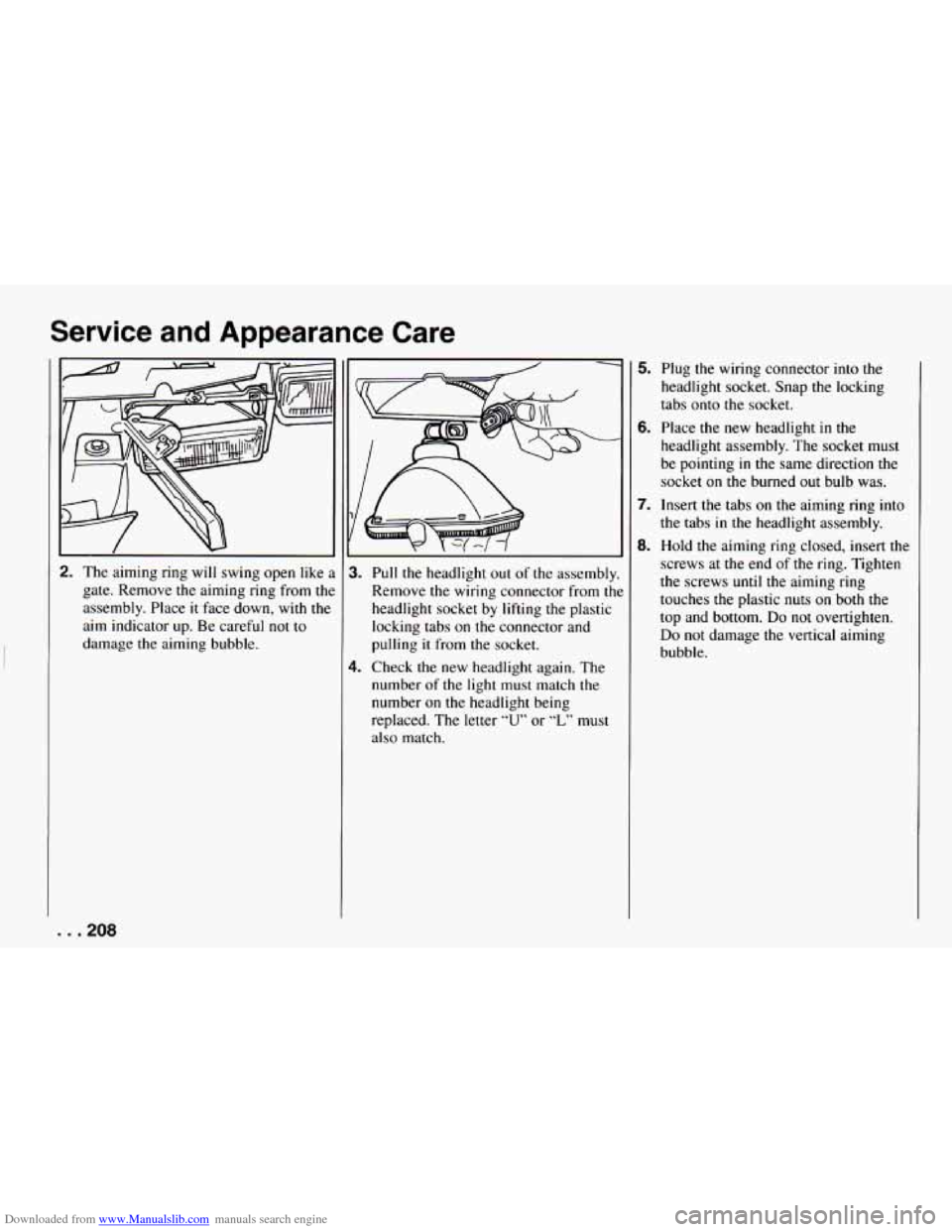
Downloaded from www.Manualslib.com manuals search engine Service and Appearance Care
2. The aiming ring will swing open like
gate. Remove the aiming ring from
thl
assembly. Place it face down, with the
aim indicator up. Be careful not to
damage
the aiming bubble.
. . .208
I
-
a3
e
4,
Pull the headlight out of the assembly.
Remove the wiring connector from
thl
headlight socket by lifting the plastic
locking tabs on the connector and
pulling
it from the socket.
Check the new headlight again. The
number
of the light must match the
number on the headlight being
replaced. The letter
“U” or “L” must
also match.
5.
6.
7.
0.
Plug the wiring connector into the
headlight socket. Snap the locking
tabs onto the socket.
Place the new headlight in the
headlight assembly. The socket must
be pointing
in the same direction the
socket on
the burned out bulb was.
Insert the tabs on the aiming ring into
the tabs
in the headlight assembly.
Hold the aiming ring closed, insert the
screws at the end of the ring. Tighten
the screws until the aiming ring
touches the plastic nuts on
both the
top and bottom.
Do not overtighten.
Do not damage the vertical aiming
bubble.
Page 211 of 292
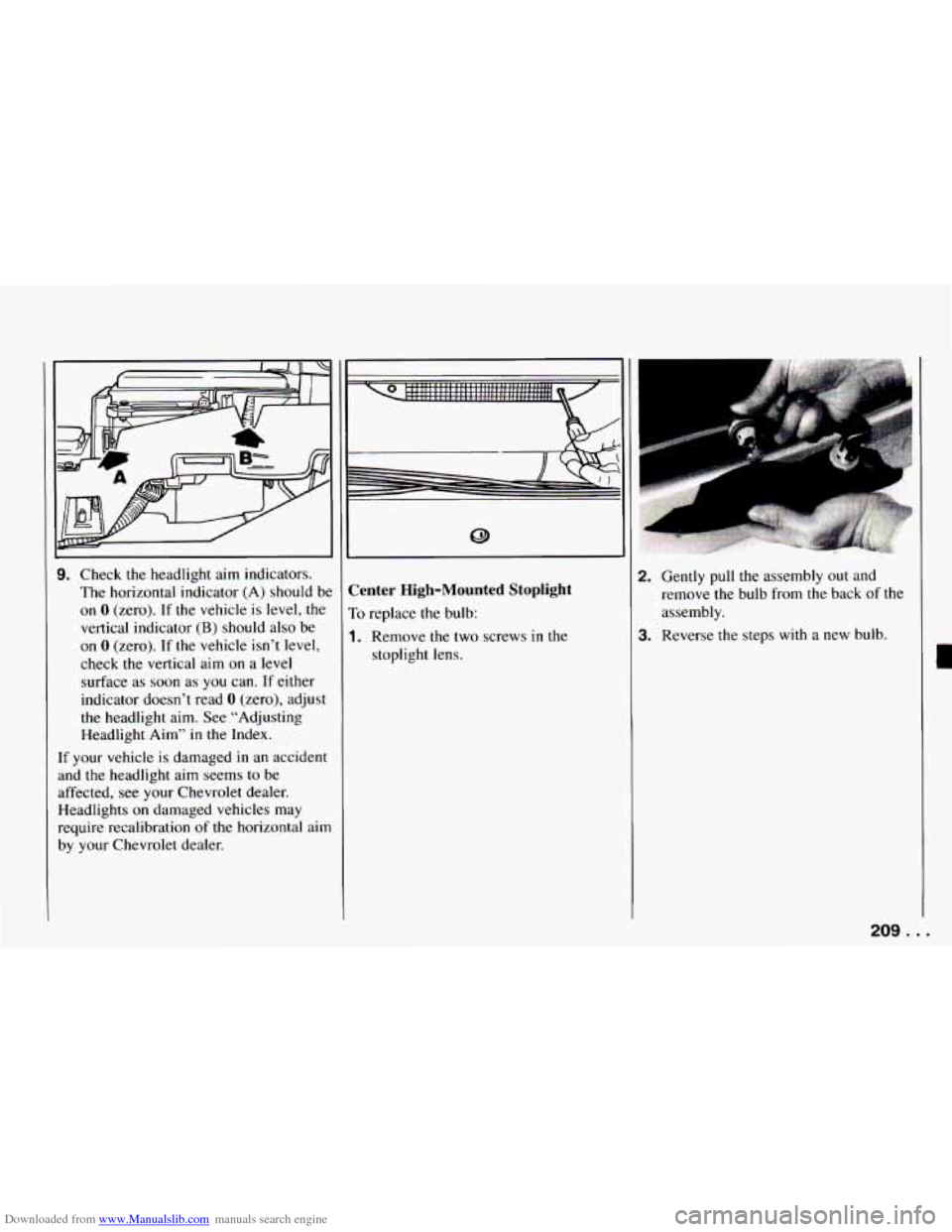
Downloaded from www.Manualslib.com manuals search engine 9. Check the headlight aim indicators.
The horizontal indicator (A) should be
on
0 (zero). If the vehicle is level, the
vertical indicator (B) should also be
on 0 (zero). If the vehicle isn’t level,
check the vertical aim on a
level
surface as soon as you can. If either
indicator doesn’t read
0 (zero), adjust
the headlight aim. See “Adjusting Headlight Aim” in the Index.
If your vehicle is damaged in an accident
and the headlight aim seems to be
affected, see your Chevrolet dealer.
Headlights
on damaged vehicles may
require recalibration
of the horizontal aim
by your Chevrolet dealer.
s ....... I,
... I......, 1..1...... . . . , . . . . . .
Center High-Mounted Stoplight
To replace the bulb:
1. Remove the two screws in the
stoplight
lens.
2. Gently pull the assembly out and remove the bulb from
the back of the
assembly.
3. Reverse the steps with a new bulb.
209. ,
Page 218 of 292
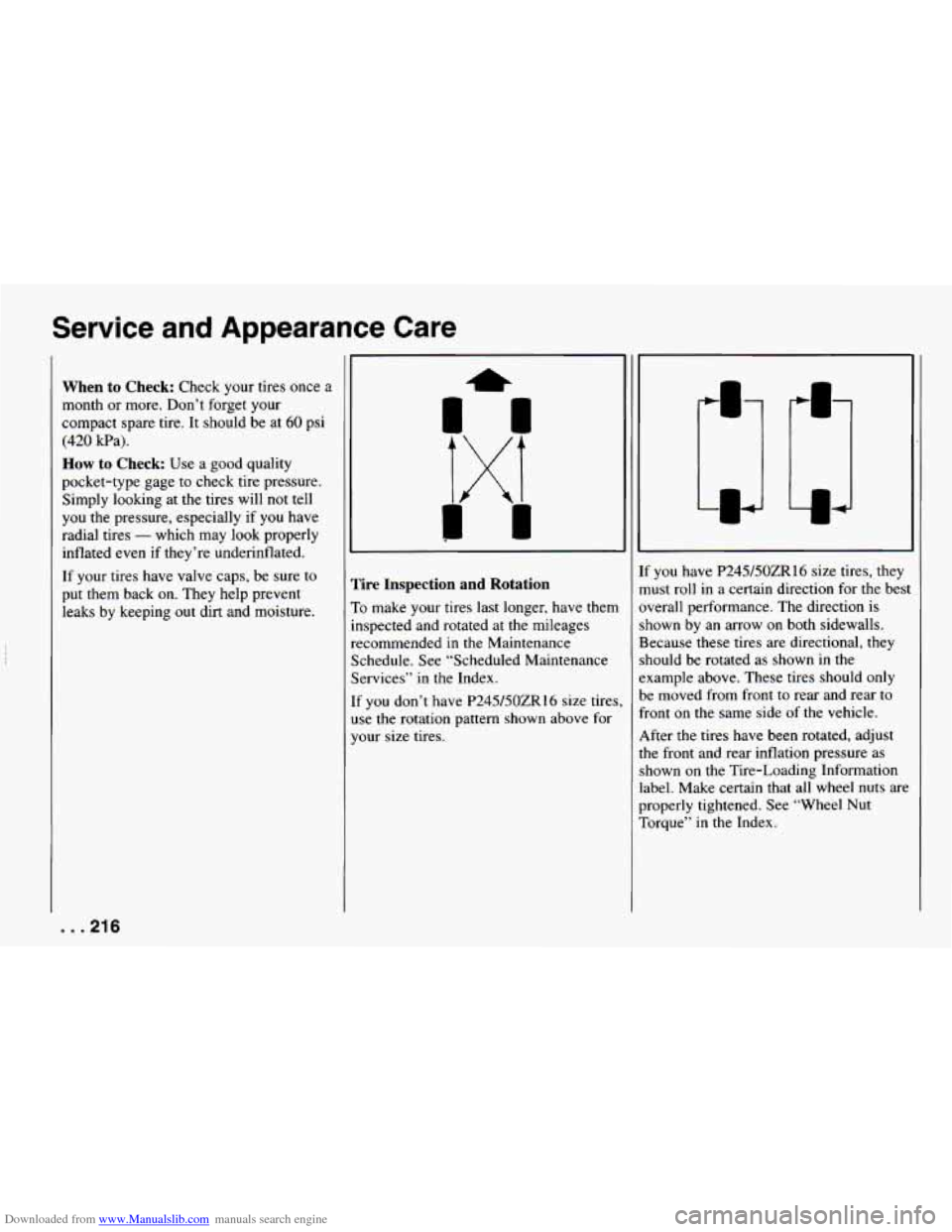
Downloaded from www.Manualslib.com manuals search engine Service and Appearance Care
When to Check: Check your tires once a
month or more. Don’t forget your
compact spare tire. It should be at
60 psi
(420 kPa).
How to Check: Use a good quality
pocket-type gage to check tire pressure.
Simply looking at the tires will not tell
you the pressure, especially if you have
radial tires
- which may look properly
inflated even
if they’re underinflated.
If your tires have valve caps, be sure to
put them back on. They help prevent
leaks by keeping out dirt and moisture. Tire Inspection and Rotation
To make your tires last longer, have them
inspected and rotated at the mileages
recommended
in the Maintenance
Schedule. See “Scheduled Maintenance
Services” in the Index.
[f you don’t have P245/50ZR16 size tires
use the rotation pattern shown above for
your size tires.
4-
f you have P245/50ZR16 size tires, they
nust roll in
a certain direction for the best
werall performance. The direction is
hown by an arrow on both sidewalls.
3ecause these tires are directional, they
hould be rotated as shown
in the
:xample above. These tires should only
,e moved from front to rear and rear to
ront on the same side of the vehicle.
ifter the tires have been rotated, adjust
he front and rear inflation pressure as
.hown on
the Tire-Loading Information
abel. Make certain that all wheel nuts are
u-operly tightened. See “Wheel Nut
rorque” in the Index.
. . .216
Page 219 of 292
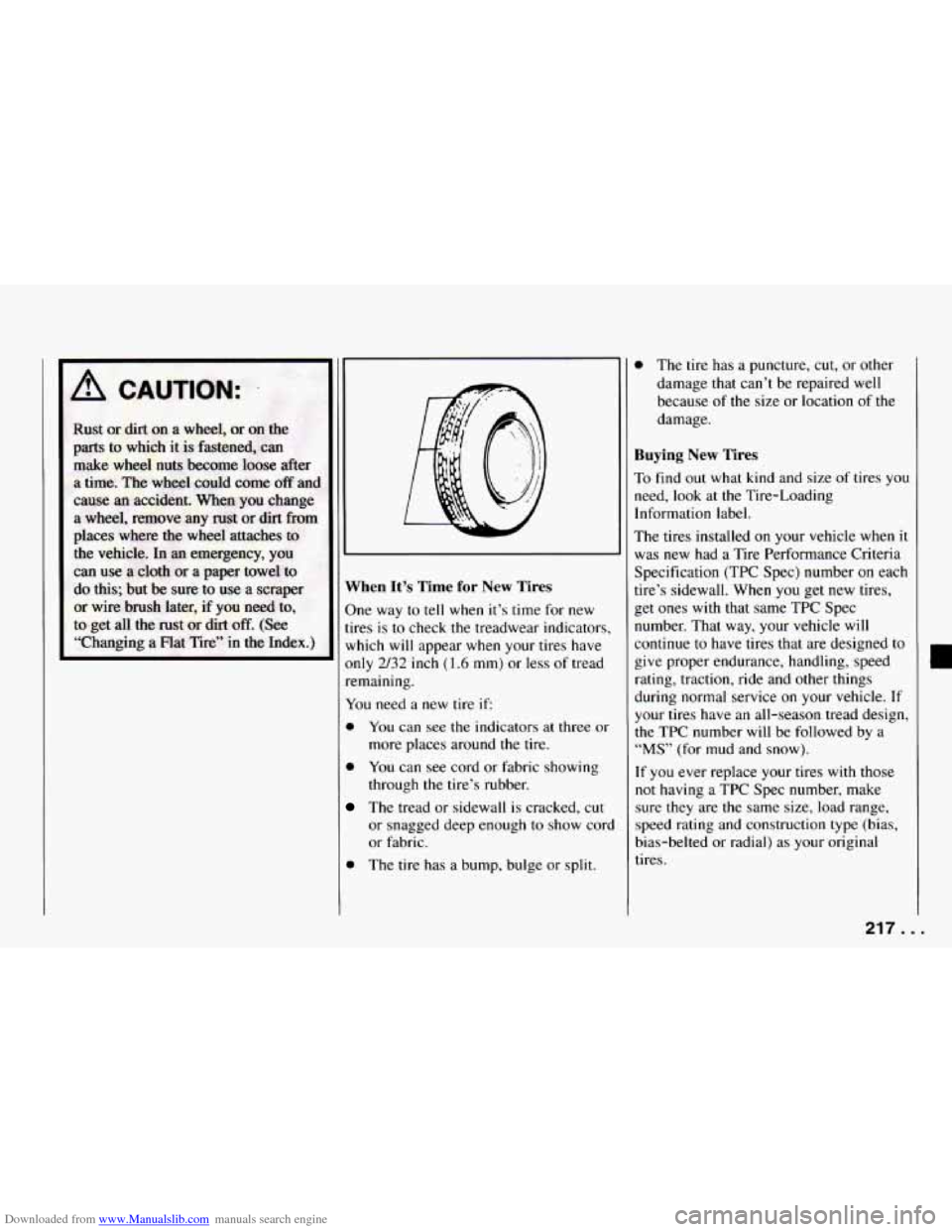
Downloaded from www.Manualslib.com manuals search engine When It’s Time for New Tires
One way to tell when it’s time for new
tires is to check the treadwear indicators,
which
will appear when your tires have
only
2/32 inch (1.6 mm) or less of tread
remaining.
You need a new tire if:
0 You can see the indicators at three or
more places around the tire.
0 You can see cord or fabric showing
through
the tire’s rubber.
The tread or sidewall is cracked, cut
or snagged deep enough to show cord
or fabric.
0 The tire has a bump, bulge or split. The tire
has a puncture, cut, or other
damage that can’t be repaired
well
because of the size or location of the
damage.
Buying New Tires
To find out what kind and size of tires you
need, look at the Tire-Loading
Information label.
The tires installed on your vehicle when it
was new had a Tire Performance Criteria
Specification (TPC Spec) number on each
tire’s sidewall. When you get new tires,
get ones
with that same TPC Spec
number. That way, your vehicle
will
continue to have tires that are designed to
give proper endurance, handling, speed
rating, traction, ride and other things
during normal service on your vehicle. If
your tires have an all-season tread design,
the TPC number
will be followed by a
“MS” (for mud and snow).
If you ever replace your tires with those
not having a TPC Spec number, make
sure they are the same size, load range,
speed rating and construction type (bias,
bias-belted or radial) as your original
tires.
217 ...
Page 225 of 292
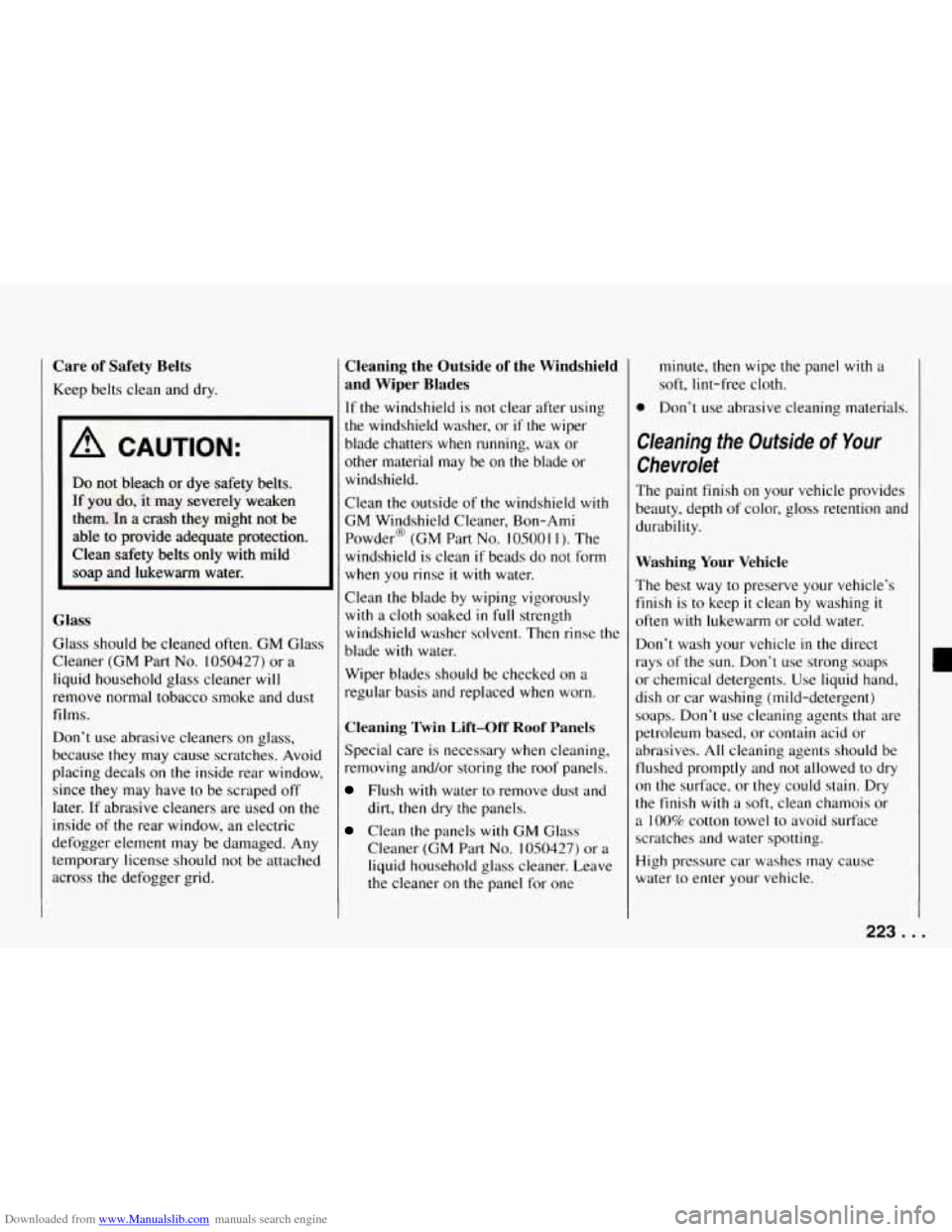
Downloaded from www.Manualslib.com manuals search engine Care of Safety Belts
Keep belts clean and dry.
A CAUTION:
Do not bleach or dye safety belts.
If YOU do, it may severely weaken
them. In a crash they might not be
able to provide adequate protection.
Clean safety belts
only with mild
soap
and lukewarm water.
Glass
Glass should be cleaned often. GM Glass
Cleaner (GM Part
No. 1050427) or a
liquid household glass cleaner will
remove normal tobacco smoke and dust
films.
Don’t use abrasive cleaners on glass,
because they may cause scratches. Avoid
placing decals on the inside rear window,
since they
may have to be scraped off
later. If abrasive cleaners are used on the
inside of the rear window, an electric
defogger element may be damaged.
Any
temporary license should not be attached
across the defogger grid.
I
Cleaning the Outside of the Windshield
and Wiper Blades
If the windshield is not clear after using
the windshield washer, or
if the wiper
blade chatters when running, wax or
other material
may be on the blade or
windshield.
Clean the outside
of the windshield with
GM Windshield Cleaner, Bon-Ami
Powder@ (GM Part
No. 10500 1 1 ). The
windshield is clean
if beads do not form
when you rinse
it with water.
Clean the blade
by wiping vigorously
with a cloth soaked in full strength
windshield washer solvent. Then rinse the
blade with water.
Wiper blades should be checked on a
regular basis and replaced when worn.
Cleaning Twin Lift-off Roof Panels
Special care is necessary when cleaning,
removing and/or storing the roof panels.
Flush with water to remove dust and
dirt, then dry the panels.
Cleaner
(GM Part No. 1050427) or a
liquid household glass cleaner. Leave
the cleaner on the panel for one
Clean the panels with GM Glass minute,
then wipe the panel
with a
soft, lint-free cloth.
0 Don’t use abrasive cleaning materials.
Cleaning the Outside of Your
Chevrolet
The paint finish on your vehicle provides
beauty, depth of color, gloss retention and
durability.
Washing Your Vehicle
The best way to preserve your vehicle’s
finish is to keep
it clean by washing it
often with lukewarm or cold water.
Don’t wash your vehicle
in the direct
rays of the sun. Don’t use strong soaps
or chemical detergents. Use liquid hand,
dish
or car washing (mild-detergent)
soaps. Don’t use cleaning agents that are
petroleum based, or contain acid or
abrasives.
All cleaning agents should be
flushed promptly and not allowed to
dry
on the surface, or they could stain. Dry
the finish
with a soft, clean chamois or
a
100% cotton towel to avoid surface
scratches and water spotting.
High pressure car washes may cause
water to enter your vehicle.
223 .
Page 229 of 292

Downloaded from www.Manualslib.com manuals search engine I
w Vehicle Identification
Number (VIN)
This is the legal identifier for your
Chevrolet. It appears on a plate in the
front corner of the instrument panel, on
the driver’s side. You can see it if you
look through the windshield from outside
your vehicle. The VIN also appears on the
Vehicle Certification and Service Parts
labels and the certificates of title and
registration.
Engine Identification
The eighth character in your VIN is the
engine code. This code will help you
identify your engine, specifications, and
replacement parts.
Service Parts
Identification Label
You’ll find this label inside your console
itorage compartment. It’s very helpful if
you ever need to order parts. On this
label is:
D your VIN,
the model designation,
paint information, and
a list of all production options anc
special equipment.
Be sure that this label is not removed
From the vehicle.
Add-on Electrical
Equipment
NOTICE:
Don’t add anything electrical to your
Chevrolet unless
you check with
your dealer first. Some electrical
equipment can damage your vehicle
and the damage wouldn’t be covered
by your warranty. Some add-on
electrical equipment can keep other
components from working as they
should.
Your vehicle has an air bag system.
Before attempting to add anything
electrical to your Chevrolet, see
“Servicing Your Air Bag-Equipped
Chevrolet” in the Index.
227. . .